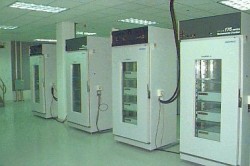
The US Naval Observatory operates 70 cesium atomic clocks. Credit: USNO
If you ever feel like you need more time, here’s some great news: you’re actually going to get it. On December 31, 2008 a “leap second” will be added to the world’s clocks at 23 hours, 59 minutes and 59 seconds Coordinated Universal Time (UTC). This corresponds to 6:59:59 pm Eastern Standard Time, when the extra second will be inserted at the U.S. Naval Observatory’s Master Clock Facility in Washington, DC. This is the 24th leap second added to UTC, a uniform time-scale kept by atomic clocks around the world, since 1972. Coincidentally, Fraser and Pamela’s most recent episode of Astronomy Cast is about time, so if you want to know more about time and the atomic clocks used to provide precise timekeeping, check it out.
Historically, time was based on the mean rotation of the earth relative to celestial bodies and the second was defined in this reference frame. However, the invention of atomic clocks defined a much more precise “atomic time” scale and a second that is independent of the earth’s rotation. In 1970, an international agreement established two timescales: one based on the rotation of the earth and one based on atomic time.
Atomic clocks do not use radioactivity, but they use the exact frequency of the microwave spectral line emitted by atoms of the element cesium, in particular its isotope of atomic weight 133 (“Cs-133”). The integral of frequency is time, so this frequency, 9,192,631,770 hertz (Hz = cycles/second), and this provides the fundamental unit of time, which are measured by cesium clocks.
The problem is that the earth’s rotation is very gradually slowing down, which necessitates the periodic insertion of a “leap second” into the atomic timescale to keep the two within 1 second of each other. The International Earth Rotation and Reference Systems Service (IERS) is the organization which monitors the difference in the two timescales and calls for leap seconds to be inserted or removed when necessary.
Since 1972, leap seconds have been added at intervals varying from six months to seven years, with the last being inserted on December 31, 2005. The U.S. Naval Observatory is charged with the responsibility for the precise determination and dissemination of time for the Department of Defense and maintains its Master Clock. The U.S. Naval Observatory, together with the National Institute of Standards and Technology (NIST), determines time for the United States.
Source: US Naval Observatory